|
Meinem Lehrer und Freund Prof. Dr. Heinrich von Stietencron ist die gesamte Amarakośa-Übersetzung in Dankbarkeit gewidmet. |
Zitierweise | cite as: Amarasiṃha <6./8. Jhdt. n. Chr.>: Nāmaliṅgānuśāsana (Amarakośa) / übersetzt von Alois Payer <1944 - >. -- 2. Dvitīyaṃ kāṇḍam. -- 13. brahmavargaḥ (Über Brahmanen). -- 3. Vers 31c - 40. (
Brahmanen: Gastfreundschaft, Askese I, vedische Vorschriften). -- Fassung vom 2011-03-22. -- URL: http://www.payer.de/amarakosa5/amara213c.htmErstmals hier publiziert: 2011-03-22
Überarbeitungen:
©opyright: Creative Commons Lizenz (Namensnennung, keine kommerzielle Nutzung, share alike)
Dieser Text ist Teil der Abteilung Sanskrit von Tüpfli's Global Village Library
|
Meinem Lehrer und Freund Prof. Dr. Heinrich von Stietencron ist die gesamte Amarakośa-Übersetzung in Dankbarkeit gewidmet. |
Falls Sie die diakritischen Zeichen nicht dargestellt bekommen, installieren Sie eine Schrift mit Diakritika wie z.B. Tahoma.
Die Devanāgarī-Zeichen sind in Unicode kodiert. Sie benötigen also eine Unicode-Devanāgarī-Schrift.
| 31c./d. paryeṣaṇā parīṣṭiś
cānveṣaṇā ca gaveṣaṇā पर्येषणा परीष्टिश् चान्वेषणा च गवेषना ॥३१ ख॥ [Bezeichnungen für Untersuchung:]
|
Colebrooke (1807): "Research or inquiry. Especially the investigation of duty by reasoning."
| 32a./b. sanis tv
adhyeṣaṇā yācñābhiśastir yācanārthanā सनिस् त्व् अध्येषणा याच्ञाभिशस्तिर् याचनार्थना ।३२ क।
|
Colebrooke (1807): "Request or solicitation."
| 32a./b. sanis tv adhyeṣaṇā
yācñābhiśastir yācanārthanā सनिस् त्व् अध्येषणा याच्ञाभिशस्तिर् याचनार्थना ।३२ क। [Bezeichnungen für Bitten:]
|
Colebrooke (1807): "Asking or begging."
अभिशस्ति - abhiśasti f.: Verwünschung (dreiste Forderung)

Abb.: अभिशतिः । "A little girl dressed up like a demon,
collects money to offer to Goddess. This is just before going to the
Mutharamman temple, Kulasekaranpatinam - குலசேகரன்பட்டனத்தில்,
TamilNadu."
[Bildquelle: pee vee. --
http://www.flickr.com/photos/peeveeads/2929055532/. -- Zugriff am
2011-03-19. --
Creative Commons Lizenz (Namensnennung, keine kommerzielle Nutzung,
keine Bearbeitung)
| 32c./d. ṣaṭ tu triṣv arghyam
arghārthe
pādyaṃ pādāya vāriṇi षट् तु त्रिष्व् अर्घ्यम् अर्घार्थे पाद्यं पादाय वारिणि ॥३२ ख॥ Die folgenden sechs Wörter kommen in allen drei grammatischen Geschlechtern vor. Was des अर्घ - argha m. - feierliche Aufnehme eines Gastes, dient, heißt अर्घ्य - arghya 3: zur Ehrengabe geeignet |
Colebrooke (1807): "A respectful oblation. Water only ; or else grass, flowers, &c. with water."
"§ 53. Außer den regelmäßigen Opfern gibt es weitere, nur bei bestimmten Gelegenheiten auszuübende Pflichten für den Hausherrn; vor allem den argha; »argha ist der Name der feierlichen Aufnahme eines Gastes, bei welcher demselben Ehrenwasser (arghya) und die Honigspeise (madhuparka) überreicht wird« (Stenzler zu P. i, 3, 1). Die Pflicht hierzu wird besonders nachdrücklich mit Versen, die z. T. Manu entlehnt sind, von Ś. erläutert. Sechs Personen sind mit dem Argha zu empfangen
- der ācārya,
- der Priester,
- der snātaka (der am Tage seiner Entlassung oder als Freier kommt, cf. Komm, zu Āśv. 1, 24, 2),
- ein Verschwägerter,
- der König oder
- ein Freund.
Der »Verschwägerte« wird als vaivāhya (vivāhya G. 4, 10, 24) bezeichnet. Der Kommentar zu P. 1, 3. G. u. a. erklärt ihn als jāmātṛ. Āśv. setzt dafür direkt śvaśura, pitṛvya, mātula ein; Āp. 13, 19; ŚSr. 4, 21, 1 den śvaśura; »priya« wird bisweilen weggelassen; doch ist nach dem Schol. zu ŚSr. dies der Freier. Alle diese soll man ehren, wenn sie kommen, aber nur einmal im Jahre (P. G. Āp.), dagegen immer wieder die zu Opfern geladenen Priester. Āp. fügt 13, 20 noch hinzu, dass man einen berühmten Vedalehrer (pravaktṛ citra) einmal mit dem Argha empfangen solle. Die Arghagaben sind sechs an Zahl:
- ein oder zwei Kissen (vistara, kürca) als Sitz resp. Unterlage für die Füße,
- Fußwasser,
- Arghawasser,
- Mundspülwasser,
- Madhuparka und
- eine Kuh.
H., der diese Zeremonien im Zusammenhange mit der Heimkehr des Snātaka beschreibt, setzt bis aufs Einzelne die Worte fest, welche bei der Darreichung der Gaben zu wechseln sind. Der Ankömmling geht auf die Person, die ihm Ehre erweisen will, zu und blickt sie mit den Worten an: »Ruhm bist du, Ruhm möchte ich bei dir werden.« Nachdem der Wirt ihm Herberge bereitet hat, sagt dieser »argha/!« und der Gast erwidert: »kuruta!« Die Gegenstände werden der Reihe nach einzeln dargeboten. Er nimmt die Kissen in Empfang, setzt sich darauf und lässt sich die Füße waschen. Hierauf wird das (nach dem Komm, zu Āśv. 1, 24, 13) gewürzte Arghyawasser dargereicht, ein Teil über die zusammengelegten Hände gegossen, der Rest ausgeschüttet (P. 1, 3, 14; H. 1, 13, 3), all das unter beständiger Anwendung von Sprüchen. Hierauf folgt die Darbietung des Spülwassers und des Madhuparka. Dieser besteht nach H. 1, 12, 10 aus drei oder fünf Bestandteilen, nämlich
- dadhi,
- madhu,
- ghṛta,
wozu noch
- āpaḥ und
- saktu's
treten können. Manche nehmen nur dadhi und madhu. Wenn man Honig nicht bekommt, dann nach Āśv. 1, 24, 6 an Stelle davon Butter. Die saure Milch wird in ein Messinggefäß gegossen (H.), dazu dann die anderen Substanzen. Auch hier finden sich ganz ins Einzelne gehende Vorschriften. Der Gast isst entweder alles oder lässt einen Rest, den er einem Brahmanen gibt (G. Āśv.) oder einem Sohn oder Schüler (P.) oder einem, der ihm günstig ist (H.) oder einem anukampya (Āp.). Doch kann der Überrest auch weggeschüttet werden. Ein König oder Häuptling (sthapati) soll die Gabe überhaupt nur annehmen und seinem Purohita übergeben (Āp. 13, 14).
Zuletzt wird die »Kuh« geschenkt. Dass der Argha nicht ohne Fleisch sein soll, wird mehrfach vorgeschrieben (Āśv. 1, 24, 33; P. x, 3, 29; Ś. 2, 15, 2; H. 1, 13, 14); doch gestattet Ś. anstelle eines Rindes auch eine Ziege oder was für eine Speise er »für die ähnlichste« hält (S. 73). Nach demselben Sūtra ist das Tier für den Lehrer Agni geweiht, das für den Priester Bṛhaspati, für Verschwägerte Prajāpati, für den König Indra, für den Snātaka Indrāgnī, für den Freund Mitra. Er nimmt ein Schlachtmesser und sagt dreimal zu dem Gast: »die Kuh!« (P.). Bei G.4,10,18, demzufolge die Kuh schon zu Anfang im N. angebunden steht und mit Sprüchen begrüßt wird, kündigt der Barbier (nāpita), die Kuh an. Der Gast kann sie mit oṃ kuruta! (Āśv. 1, 24, 31; G. 4, 10, 22) schlachten - oder mit oṃ sṛjata freilassen. Für beide Fälle sind besondere Sprüche vorgeschrieben, doch weichen die Sūtren so von einander ab, dass P. 1, 3, 27. 28 die Sprüche umgekehrt verwendet von Āśv. 1, 24, 31. 32. Im Fall der Freilassung bereitet man ein Mahl aus anderem Fleisch und sagt zu dem Gast bhūtam! (H. 1, 13, 14), worauf dieser »subhūtam u. s. w.« erwidert und die Brahmanen speisen lässt. Er selbst lässt sich eine andere Speise bringen und gibt den Rest einem Freunde.
Litt.: Stenzler, Glückwunsch an v. Humboldt, nebst einem Bruchstück aus Pāraskara's Darstellung des häusl. Gebr. 1855. Weber, Ind. Streif. II, 116. Rajendralala Mitra, JASB. 41, 190 ff. — cf. Uttararāmacar. Akt IV."
[Quelle: Hillebrandt, Alfred <1853-1927>: Ritual-Litteratur, vedische Opfer und Zauber. -- Strassburg, Trübner 1897. -- 199 S. -- (Grundriss der indo-arischen Philologie und Altertumskunde ; III,2). -- S. 79f.]
| 32c./d. ṣaṭ tu triṣv arghyam arghārthe
pādyaṃ pādāya vāriṇi षट् तु त्रिष्व् अर्घ्यम् अर्घार्थे पाद्यं पादाय वारिणि ॥३२ ख॥ Das Wasser für den Fuß heißt पाद्य - pādya n.: zum Fuß gehörend, Fußwasser |
Colebrooke (1807): "Water for ablution of the feet."
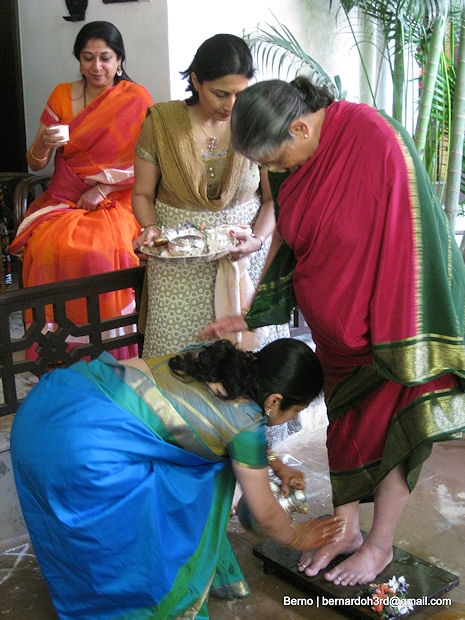
Abb.: पाद्यम् । Fußwaschung als Begrüßungsritual,
Thiruvananthapuram - തിരുവനന്തപുരം,
Kerala
[Bildquelle: Bernard Oh. --
http://www.flickr.com/photos/bernardoh/4239356739/in/photostream/. --
Zugriff am 2011-03-19. --
Creative Commons Lizenz (Namensnennung, keine Bearbeitung)]
| 33a./b. kramād ātithyātitheye
atithyarthe 'tra sādhuni क्रमाद् आतिथ्यातिथेये अतिथ्यर्थे ऽत्र साधुनि ।३३ क।
|
Colebrooke (1807): "Proper for a guest."
आतिथ्य - ātithya n.: für einen Gast bestimmt, gastlich
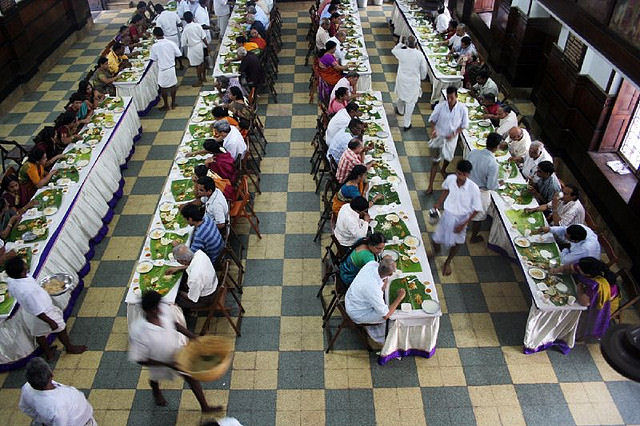
Abb.: आतिथ्यम्
। Hochzeitsgäste, Chennai -
சென்னை,
Tamil Nadu
[Bildquelle: swamysk. --
http://www.flickr.com/photos/swamysk/2317923383/. -- Zugriff am
2011-03-19. -- Creative Commons Lizenz (Namensnennung, keine kommerzielle
Nutzung, keine Bearbeitung)]
आतिथेय - ātitheya n.: gut für einen Gast bestimmt, gastfreundlich
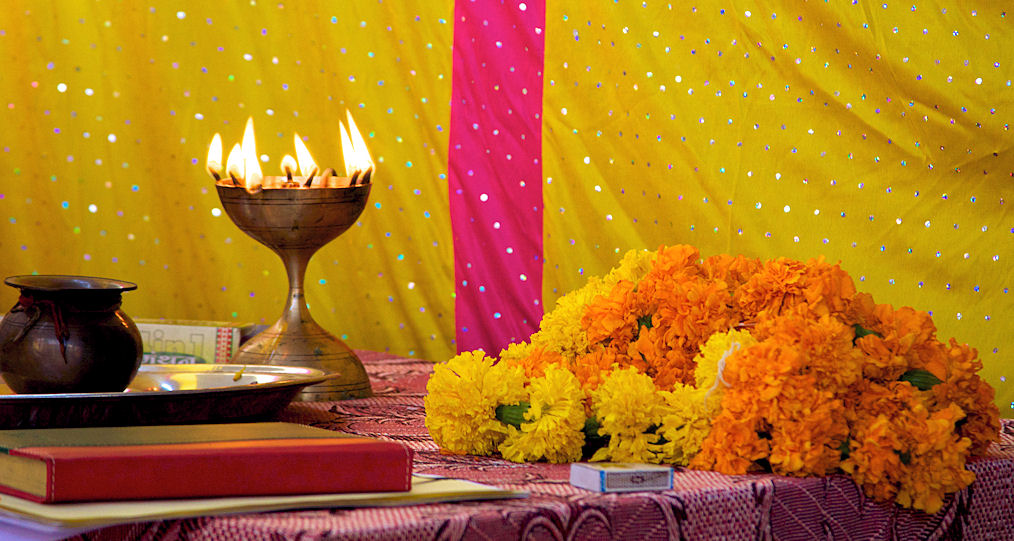
Abb.: आतिथेयानि । Requisiten für Willkommens-Pūjā, Dhar
District - धार जिला,
Madhya Pradesh
[Bildquelle: McKay Savage. --
http://www.flickr.com/photos/mckaysavage/5102854626/. -- Zugriff am
2011-03-19. --
Creative
Commons Lizenz (Namensnennung)]
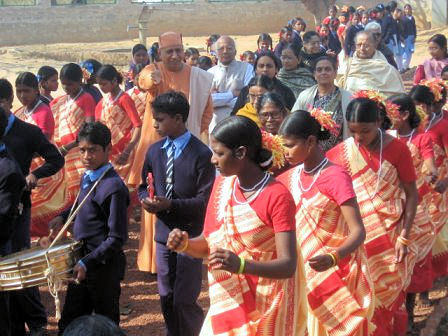
आतिथेयम् । "Teachers and students of
Vivekananda Vidyalaya, a rural school for poor children in Ranchi [राँची
/ রাঁচি]
District, Jharkhand, India welcoming Swami Vimokshananda and guests from
Bhagalpur [भागलपुर, Bihar] and Kolkata [কলকাতা,
West Bengal] with band and dance"
[Bildquelle: rkmtbs. --
http://www.flickr.com/photos/vmo/82027186/in/photostream/. -- Zugriff am
2011-03-19. --
Creative Commons Lizenz (Namensnennung, keine kommerzielle Nutzung)]

Abb.: आतिथेयानि । "At the end of any religious function in
India, bags containing a coconut and other items are handed to the guests as
a symbol of thanks and wishes of prosperity for the guest.", Bangalore -
ಬೆಂಗಳೂರು,
Karnataka
[Bildquelle:
Balaji Dutt M V. --
http://creativecommons.org/licenses/by/2.0/. -- Zugriff am 2011-03-19.
-- Creative
Commons Lizenz (Namensnennung)]
| 33c./d. syād āveśika āgantur
atithir nā gṛhāgate स्याद् आवेशोक आगन्तुर् अतिथिर् ना गृहागते ॥३३ ख॥ Jemand, der zum Hause gekommen ist (Besuch), heißt:
|
Colebrooke (1807): "A guest."
| 34a./b. pūjā namasyāpacitiḥ
saparyārcārhaṇāḥ samāḥ पूजा नमस्यापचितिः सपर्यार्चार्हणाः समाः ।३४ क। [Bezeichnungen für Verehrung:]
|
Colebrooke (1807): "Worship. Whether adoration or respect."
पूजा - pūjā f.: Verehrung, Anbetung
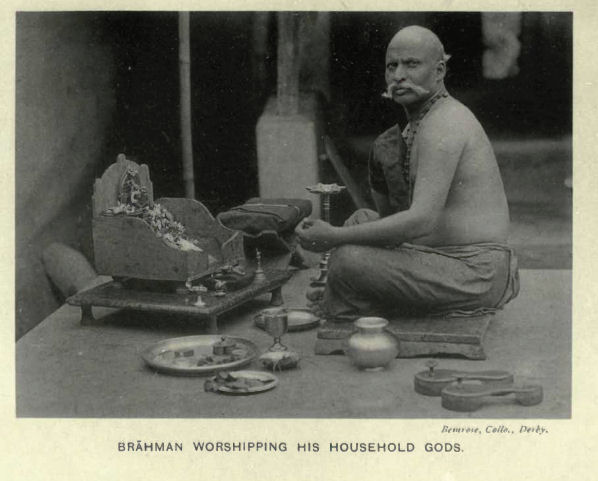
Abb.: पूजा । Brāhman worshipping his household gods
[Bildquelle: The Tribes and Castes of the Central Provinces of India / by R.
V. Russel and Rai Bahadur Hira
Lāl. -- Vol II. -- London, 1916. -- Nach S. 380]
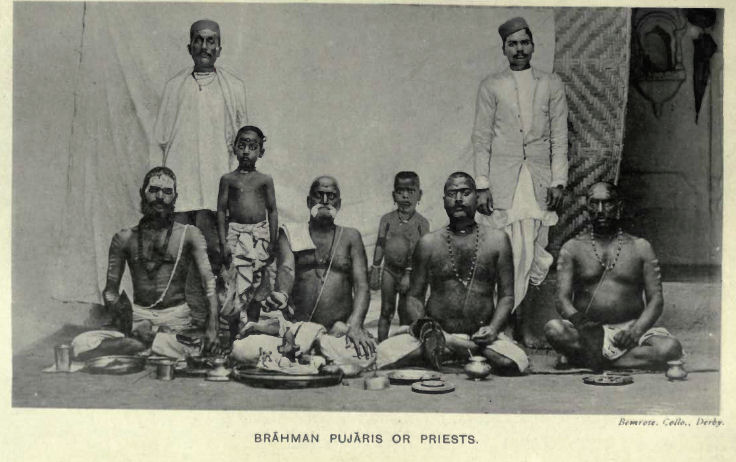
Abb.: पूजा । Brāhman Pūjāris or priests
[Bildquelle: The Tribes and Castes of the Central Provinces of India / by R.
V. Russel and Rai Bahadur Hira
Lāl. -- Vol II. -- London, 1916. -- Nach S. 390]
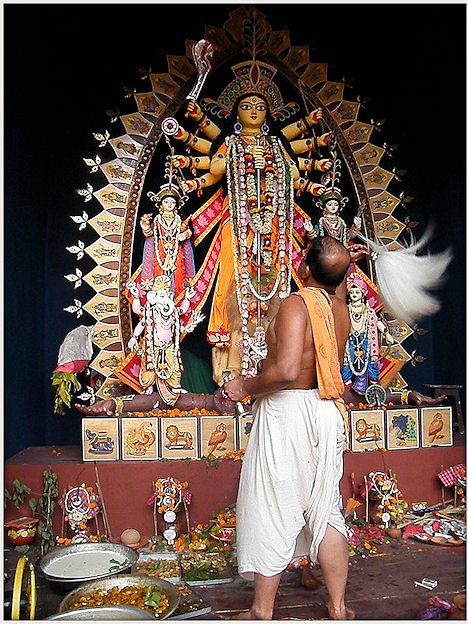
Abb.: दुर्गापूजा । West Bengal
[Bildquelle: ritankar. --
http://www.flickr.com/photos/ritankarsarkar/5148300220/. -- Zugriff am
2011-03-19. --
Creative
Commons Lizenz (Namensnennung, keine kommerzielle Nutzung, share alike)]
नमस्या - namasyā f.: Verbeugung, Verehrung, Huldigung
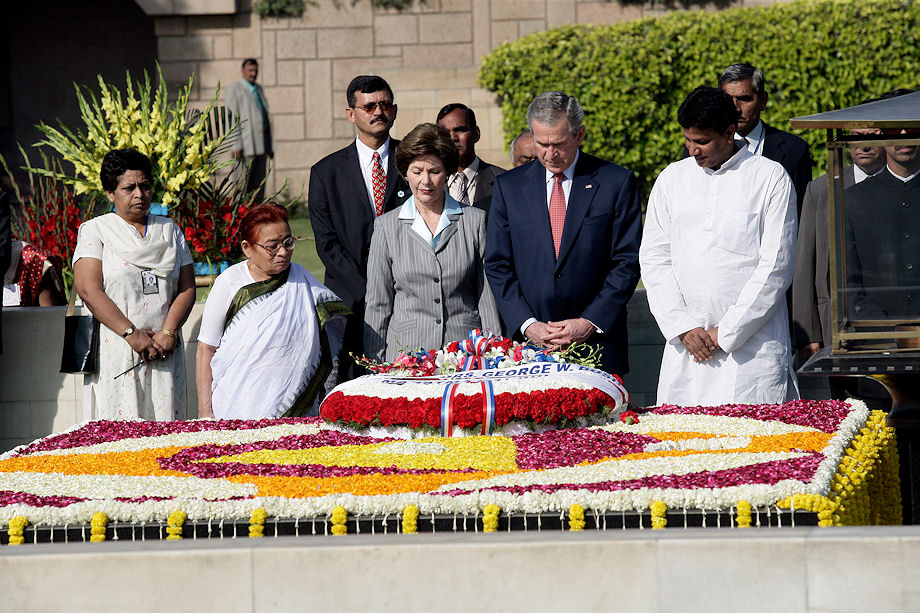
Abb.: नमस्या । US-Präsident George W. Bush an Mahatma
Gandhi's Samādhi, New Delhi, 2006
[Bildquelle: US Embassy New Delhi. --
http://www.flickr.com/photos/usembassynewdelhi/5139274822/. -- Zugriff
am 2011-03-19. --
Creative Commons Lizenz (Namensnennung, keine Bearbeitung)]
अपचिति - apaciti f.: Vergeltung: (1) Ehrerweisung, Verehrung, (2) Bestrafung
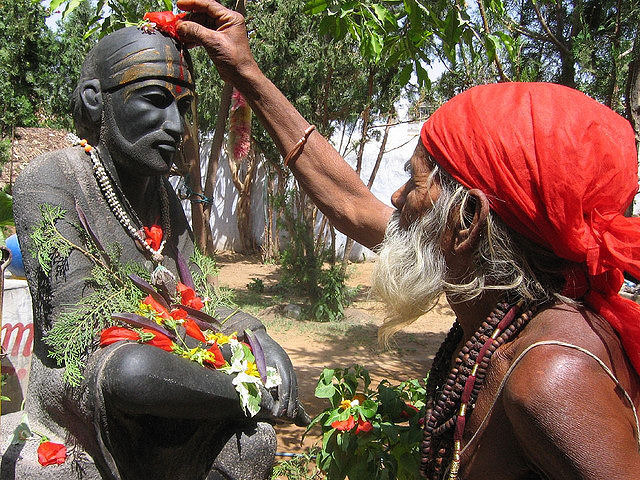
Abb.: अपचितिः । Dhana Nath Baba verehrt
Sri Sai Baba (1838 - 1918) (शिर्डीचे श्री
साईबाबा, شردی سائیں بابا)
[Bildquelle: Arno Benesch. --
http://www.flickr.com/photos/anuji_the_indian_runner/55576394/. --
Zugriff am 2011-03-19. --
Creative
Commons Lizenz (Namensnennung, keine kommerzielle Nutzung, share alike)]
सपर्या - saparyā f.: Verehrung, Huldigung
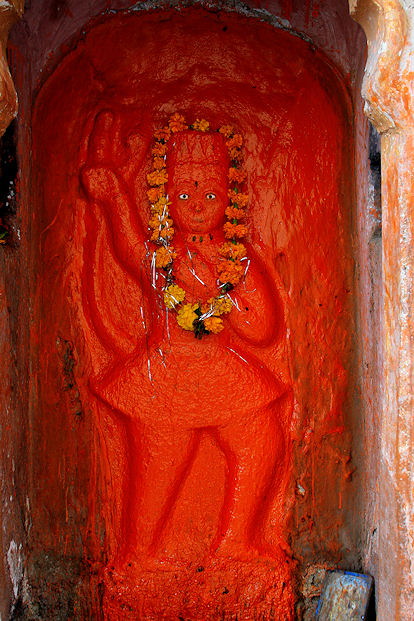
Abb.: सपर्या
। Hanuman - हनुमान् , Orccha - ओरछा, Madhya Pradesh
[Bildquelle: Carol Mitchell. --
http://www.flickr.com/photos/webethere/2170766329/. -- Zugriff am
2011-03-19. --
Creative Commons Lizenz (Namensnennung, keine Bearbeitung)]
अर्चा - arcā f.: Lobpreis, Verehrung
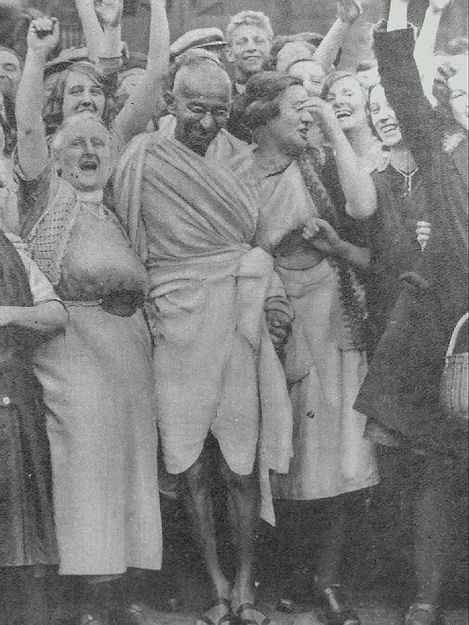
Abb.: अर्चा । Mahatma Gandhi mit Textilarbeiterinnen, Darwen, Lancashire, England, 1931-09-26
[Bildquelle: Wikimedia. -- Public domain]
अर्हणा - arhaṇā f.: Wertschätzung, Verehrung
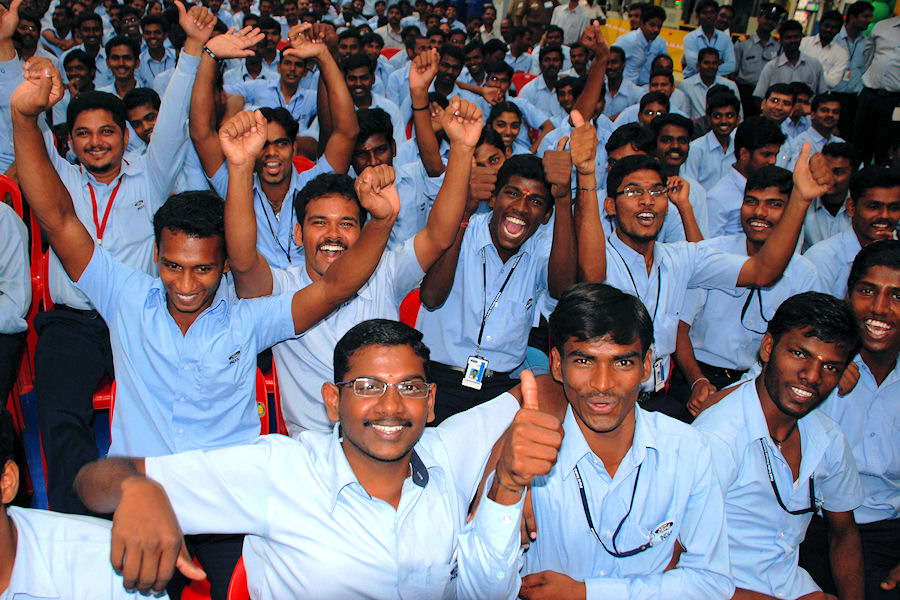
Abb.: अर्हणा । "More than 3,000
enthusiastic Ford India employees attended ceremonies at the Chennai
Integrated Manufacturing Plant marking Job 1 of the new Ford Figo and the
inauguration of the expanded engine manufacturing facility on Friday, Feb.
5", Chennai - சென்னை,
Tamil Nadu
[Bildquelle: Ford APA. --
http://www.flickr.com/photos/fordapa/4331530855/. -- Zugriff am
2011-03-19. --
Creative Commons Lizenz (Namensnennung, keine kommerzielle Nutzung)]
| 34c./d. varivasyā tu śuśrūṣā
paricaryāpy upāsanā वरिवस्या तु शुश्रूषा परिचर्याप्य् उपासना ॥३४ ख॥ [Beizeichnungen für gehorsamer Dienst:]
|
Colebrooke (1807): "Service."
वरिवस्या - varivasyā f.: Raum schaffen, Gewähren, Pflege, Diensterweisung, Verehrung
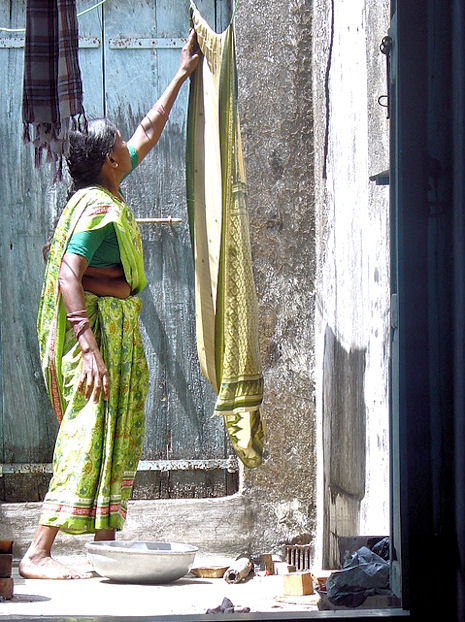
Abb.: वरिवस्या । Dienstmädchen
[Bildquelle: Hiten Mistry. --
http://www.flickr.com/photos/mistry/2477555837/. -- Zugriff am
2011-03-20. --
Creative
Commons Lizenz (Namensnennung)]
शुश्रूषा - śuśrūṣā f.: Gehorsam, gehorsamer Dienst
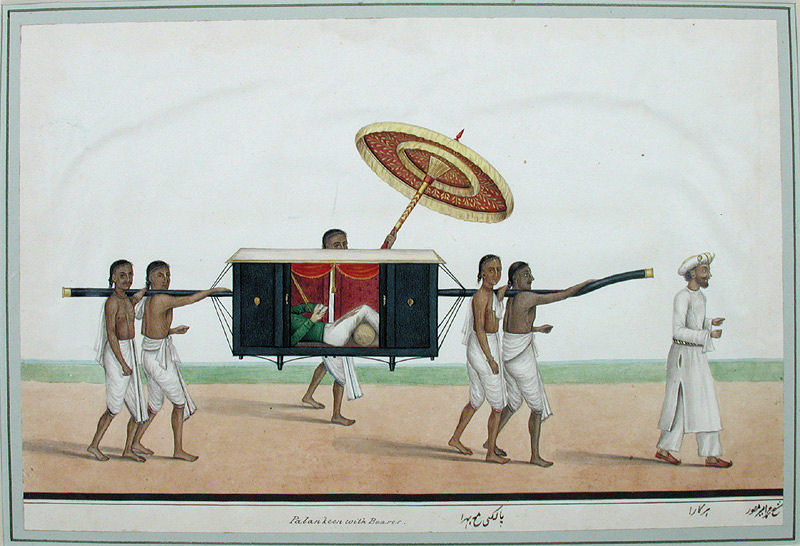
Abb.: शुश्रूषा । Mr. Holroyd liest in seiner Sänfte, West
Bengal, ca. 1835
[Bildquelle: Asian Curator at The San Diego Museum of
Art. --
http://www.flickr.com/photos/asianartsandiego/4838536018/. -- Zugriff am
2011-03-20. --
Creative Commons Lizenz (Namensnennung, keine kommerzielle Nutzung,
keine Bearbeitung)]
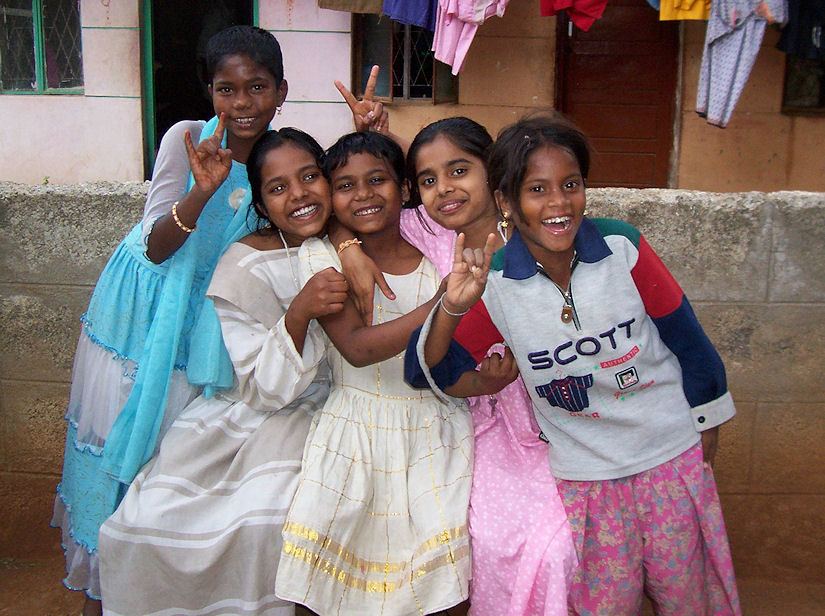
Abb.: शुश्रूषा । "These girls live in a
shelter here in Bangalore [ಬೆಂಗಳೂರು,
Karnataka]. They were all
rescued from various homes where they had been working as domestic servants.
Ameena (12) and Sultana (13) are sisters from Mumbai [मुंबई, Maharashtra],
both worked in the home of a violent and abusive women who also happened to
be a school principal. Their father sold them six years ago, their mother is
dead. Both will stay in shelters until they turn 18, beyond that their
future is uncertain. Anita on the other hand, should be going back home to
Assam very soon."
[Bildquelle:
Rani Sanghera and Jez Humble. --
http://www.flickr.com/photos/jezand_rani/239119370/. -- Zugriff am
2011-03-20. --
Creative
Commons Lizenz (Namensnennung, keine kommerzielle Nutzung, share alike)]
परिचर्या - paricaryā f.: Umsorgen, Dienst
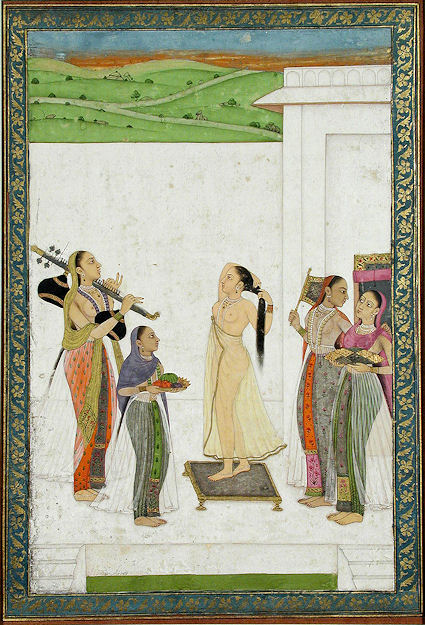
Abb.: परिचर्या । Dame bei Toilette, Andhra Pradesh, ca. 1725
[Bildquelle: Asian Curator at The San Diego Museum of
Art. --
http://www.flickr.com/photos/asianartsandiego/4838259626/. -- Zugriff am
2011-03-20. --
Creative Commons Lizenz (Namensnennung, keine kommerzielle Nutzung,
keine Bearbeitung)]
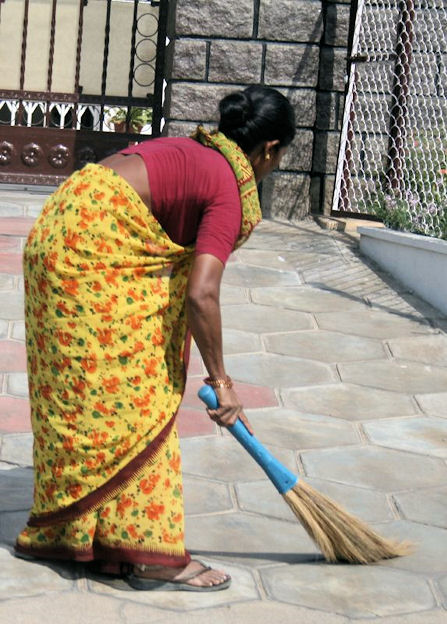
Abb.: परिचर्या । Hyderabad -
హైదరాబాద్
, Andhra Pradesh
[Bildquelle: Dan Morales. --
http://www.flickr.com/photos/moralesdirect/498286738/. -- Zugriff am
2011-03-20. --
Creative Commons Lizenz (Namensnennung, keine kommerzielle Nutzung,
keine Bearbeitung)]
उपासना - upāsanā f.: Beistand, Dienst, Verehrung, Kult
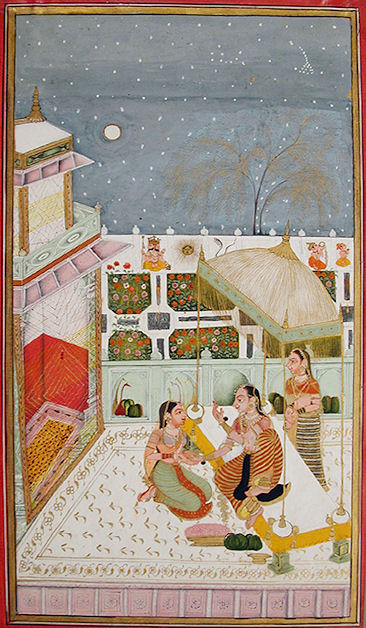
Abb.: उपासना । Dame mit zwei Dienerinnen, Rajasthan, ca. 1720
[Bildquelle: Asian Curator at The San Diego Museum of
Art. --
http://www.flickr.com/photos/asianartsandiego/4837713591/. -- Zugriff am
2011-03-20. --
Creative Commons Lizenz (Namensnennung, keine kommerzielle Nutzung,
keine Bearbeitung)]
| 35a./b. vrajyāṭāṭyā paryaṭanaṃ
caryā tv īryāpathe sthitiḥ व्रज्याटाट्या पर्यटनं चर्या त्व् ईर्यापथे स्थितिः ।३५ क। [Bezeichnungen für Umherziehen:]
|
Colebrooke (1807): "Roaming. Wandering for alms : travelling for austerity."
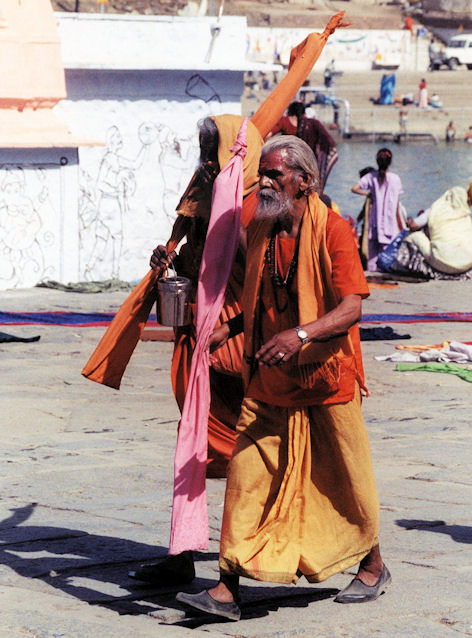
Abb.: व्रज्या । Kumbh Mela, Ujjain -
उज्जैन,
Madhya Pradesh
[Bildquelle: Nick Leonard. --
http://www.flickr.com/photos/jungle_boy/177200539/. -- Zugriff am
2011-03-20. --
Creative
Commons Lizenz (Namensnennung, keine kommerzielle Nutzung, share alike)]
अटाट्या - aṭāṭyā f.: Umherschweifen
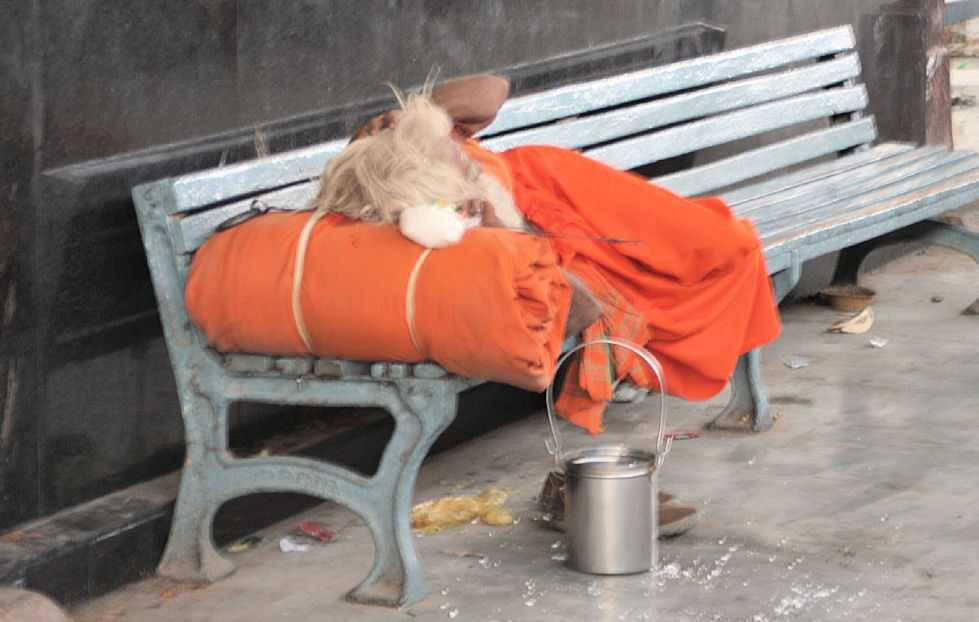
Abb.: अटाट्या
। Sādhu wartet im Bahnhof auf seinen Zug, Ajmer -
अजमेर, Rajasthan
[Bildquelle: John Haslam. --
http://www.flickr.com/photos/foxypar4/415365857/. -- Zugriff am
2011-03-20. --
Creative
Commons Lizenz (Namensnennung)]
पर्यटन - paryaṭana n.: Herumwandern
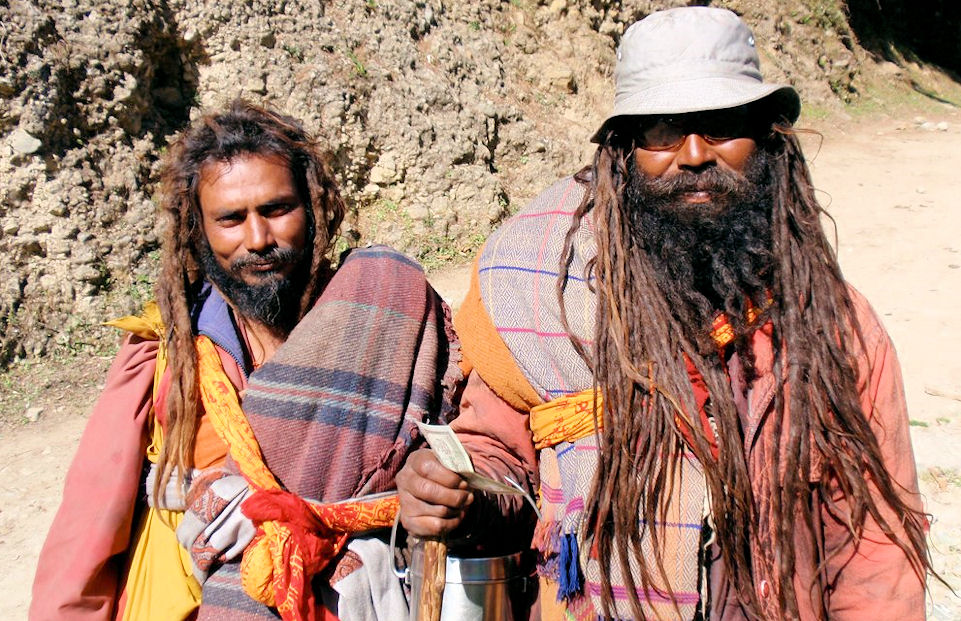
Abb.: पर्यटनम् । Sādhus auf der Heimkehr von der Pilgerreise
nach Muktinath - मुक्तिनाथ, Nepal
[Bildquelle: John Pavelka. --
http://www.flickr.com/photos/28705377@N04/3846376859/. -- Zugriff am
2011-03-20. --
Creative
Commons Lizenz (Namensnennung)]
| 35a./b. vrajyāṭāṭyā paryaṭanaṃ
caryā tv īryāpathe sthitiḥ व्रज्याटाट्या पर्यटनं चर्या त्व् ईर्यापथे स्थितिः ।३५ क। Feststehen auf dem Weg (Gelübde) des Herumwanderns heißt चर्या - caryā f.: Herumgehen, (guter) Wandel |
Colebrooke (1807): "Perseverance in austerities."
| 35c./d. upasparśas tv ācamanam
atha maunam abhāṣaṇam उपस्पर्शस् त्व् आचमनम् अथ मौनम् अभाषणम् ॥३५ ख॥ [Bezeichnungen für Ausspülen des Mundes:]
|
Colebrooke (1807): "Sipping. Touching without swallowing."
"A few words on each of the principal components of saṃdhyā may be said here. Elaborate rules about ācamana are laid down in several smṛtis; vide Gaut. I. 35-40, Āp. Dh. S. I. 5. 15. 2-11 and 16. 1-16, Manu II. 58-62, Yāj. I. 18-21. Such rules must have been elaborated from very ancient times. The Tai. Br. (I. 5. 10) prescribes that one should not perform ācamana with water that is in a cleft of the earth. Āp. Dh. S. (1. 5. 15. 5) says the same thing. One should perform ācamana in a sitting posture (and not standing nor bent) in a pure spot, facing the north or east, one should sip water thrice with water that is not hot and that is free from foam or bubbles, one should after sipping water wipe the lips twice (thrice according to Āp.) and should touch with the wet right hand one's eyes, ears, nose, heart and head. The water for ācamana should be as much as would penetrate (or reach) to the heart in the case of brāhmaṇas, to the throat in the case of kṣatriyas, to the palate in the case of vaiśyas; women and śūdras should sip on occasions of ācamana once as much water as would reach the palate. Manu (II. 18) and Yāj. (I. 18) say that water should be sipped by the brāhma tīrtha (i. e. from the root of the thumb ). The further elaborate rules laid down in such smṛtis as Gobhila gṛ. (I. 2. 5-6), Śaṅkhasmṛti 10 are not set out here. The occasions for ācamana are many. According to Gobhila gṛ. I. 1. 2 one must do every gṛhya rite with yajñopavīta worn in the usual way and after ācamana. Haradatta on Āp. Dh. S. I. 5. 15. 1 says that ācamana is a subsidiary matter in all religious acts. There are several occasions when the sipping of water twice is necessary, the principal being before and after bhojana (meals); vide Gautama I. 40, Vas. 3. 38, Yāj. I. 196, Sm. C. I. p. 100, Madanapārijāta p. 57, Par. M. I. part 1. pp. 241-143. Both the Bṛ. Up. ( VI. 1. 14) and Chān. Up. V. 2. 2 refer to the practice of sipping water before and after bhojana and the Vedāntasūtra III. 3. 18 is based on these upaniṣad passages and says that water is looked upon as the garment of prāṇa. Numerous occasions when ācamana is necessary are stated in Āp. Dh. S. I. 5. 16. 15-16, Manu V. 138 and 145, Yāj. I. 196, Kūrmapurāṇa I. 2. 13. 1-8 &c."
[Quelle: Kane, Pandurang Vaman <1880 - 1972>: History of Dharmasastra : (ancient and mediaeval, religious and civil law). -- Poona : Bhandarkar Oriental Research Institute. -- Bd. II, 1. -- 2. ed. -- 1974. -- S. 315f.]
"After performing śauca one has to rinse the mouth with twelve mouthfuls (gaṇḍūṣa) of water (vide Smṛtimuktāphala, āhnika p. 220). When one finishes the purification of the body by washing the hands and feet and by rinsing the mouth one has to engage in ācamana, A good deal has been said about ācamana above (pp. 315-316) under upanayana. Ācamana (sipping water) is to be done after tying the top-knot and tucking up the garment from behind; the water is to be poured in the hollowed palm of the hand in such a quantity that a grain of māṣa (bean) will be plunged in it and the three fingers except the thumb and the small one are to be joined together and the water is to be drunk from that part of the hand which is called brāhma tīrtha described above (n. 750). The word tīrtha means that part of the right hand by which water is taken in or poured in religious rites and the parts are given the names of deities for lauding them, as Viśvarūpa says. In most smṛtis their number is four, viz. prājāpatya or kāya, pitṛya, brāhma, and daiva (for example in Manu II. 59, Viṣṇu Dh. S. 62. 1-4, Yāj. I. 19, Mārkaṇḍeya-purāṇa 34. 103-109, Dakṣa II. 18). Some works like the Śāṭyayanakalpa and Vṛddha-Vasiṣṭha quoted by Viśvarūpa on Yāj. I. 19 name five tīrthas viz. daiva (when a brāhmaṇa faces the east, the front part of his hand), pitṛya (the right portion of the right hand), brāhma (the portion of the hand opposite the fingers ), prājāpatya (the portion of the hand near the small finger ) and pārameṣṭhya (the centre of the right palm). The Par. gr. pariśiṣṭa names the above five, except that it substitutes the name āgneya for pārameṣṭhya. The Śaṅkha-smṛti (in verse X. 1-2 ) distinguishes kāya and prājāpatya and omits the name of brāhma altogether which is called prājāpatya by it. Vaik. I. 5 has six, the usual four, the fifth being āgneya (centre of the palm ) and the sixth being ārṣa (the roots and tips of all fingers together). According to some, daiva tīrtha means the tips of the fingers and the centre of the palm is either saumya or āgneya. According to Harīta the daiva tīrtha is to be used in mārjana, worship of gods, offering of bali and in bhojana; the kāya tīrtha is to be employed in lāja-homa (homa of fried grain ) and daily homa, the pitṛya in all rites for dead ancestors. Touching the kamaṇḍalu (water jar), eating curds and fresh products of the fields (navānna) are to be done with the saumya tīrtha ( Smṛtyarthasāra p. 201 When there is difficulty of getting water and an occasion for purification by ācamana arises, one should touch one's right ear. Very elaborate rules are laid down in the digests on the subject of ācamana (e. g. Sm. C. I. pp. 95-104), Smṛtimuktāphala, Āhnika-prakāśa pp. 221-240, Āhnika-tattva pp. 333-344. Gṛ. R. pp. 150-172 &.c., which have to be all passed over for want of space. One matter to be noticed is that according to the Āpastamba-smṛti (in verse) the procedure of ācamana is of four kinds, viz. paurāṇika (in which each sipping of water is accompanied by the names, Keśava, Narāyaṇa, Mādhava &c.); smarta ( as laid down in the smṛtis like Manu II. 60 ff. ), āgama (i. e. taught in the sacred books of Śaiva and Vaiṣṇava sectarians) and śrauta (laid down in the śrautasūtras for Vedic sacrifices). The first of these four is the method usually followed now by most brāhmaṇas."
[Quelle: Kane, Pandurang Vaman <1880 - 1972>: History of Dharmasastra : (ancient and mediaeval, religious and civil law). -- Poona : Bhandarkar Oriental Research Institute. -- Bd. II, 1. -- 2. ed. -- 1974. -- S. 652f.]
| 35c./d. upasparśas tv ācamanam
atha maunam abhāṣaṇam उपस्पर्शस् त्व् आचमनम् अथ मौनम् अभाषणम् ॥३५ ख॥ [Bezeichnungen für Schweigen:]
|
Colebrooke (1807): "Silence."
| 36. ānupūrvī striyāṃ vāvṛt-paripāṭī anukramaḥ paryāyaś cātipātas tu syāt paryaya upātyayaḥ
आनुपूर्वी स्त्रियां वावृत्-परिपाटी
अनुक्रमः । [Bezeichnungen für methodisches Vorgehen:]
|
Colebrooke (1807): "Order, method."
आवृत् - āvṛt f.: Sichherwenden, Umwenden, Wendung, Handlung eines Rituals, Reihenfolge, Ordnung
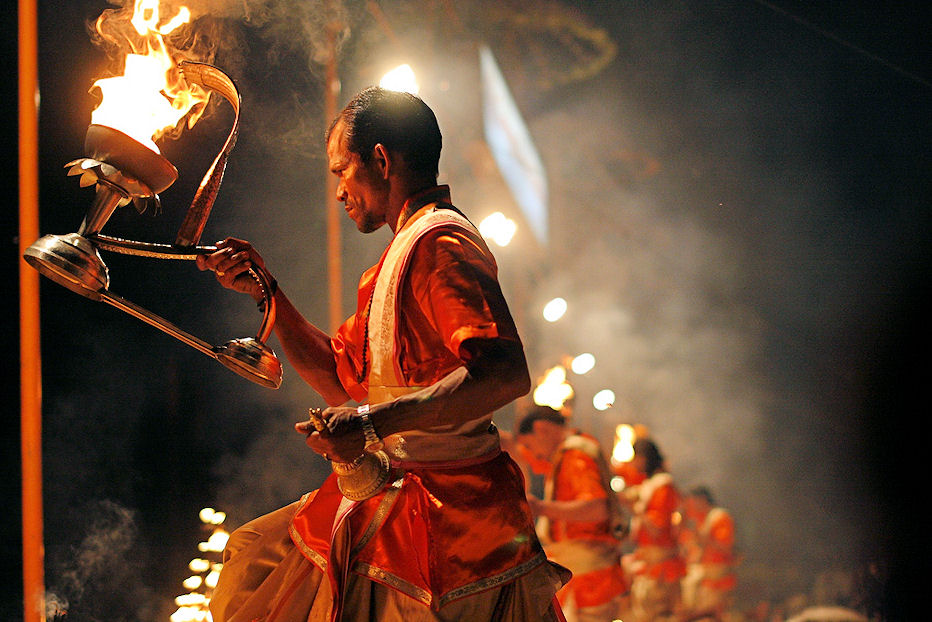
Abb.: आवृत् । Ganga-aarti - गङ्गा-आरती । Varanasi - वाराणसी,
Uttar Pradesh
[Bildquelle: Tony Kuneck. --http://www.flickr.com/photos/83762626@N00/3565475675/sizes/l/in/photostream/.
-- Zugriff am 2011-03-21. --
Creative
Commons Lizenz (Namensnennung, keine kommerzielle Nutzung, share alike)]
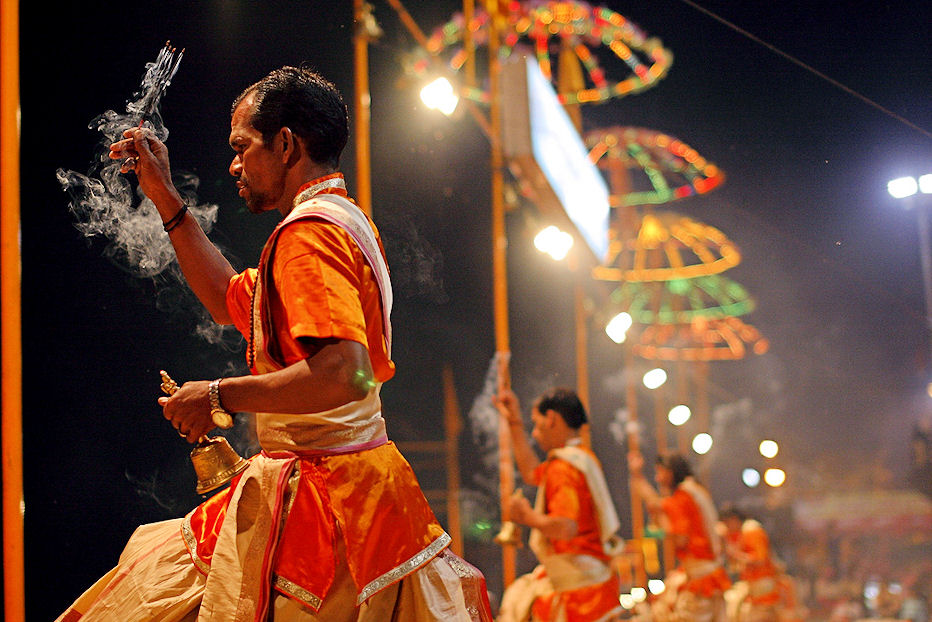
Abb.: आवृत् । Ganga-aarti - गङ्गा-आरती । Varanasi - वाराणसी,
Uttar Pradesh
[Bildquelle: Tony Kuneck. --
http://www.flickr.com/photos/83762626@N00/3566285090/. -- Zugriff am
2011-03-21. --
Creative
Commons Lizenz (Namensnennung, keine kommerzielle Nutzung, share alike)]
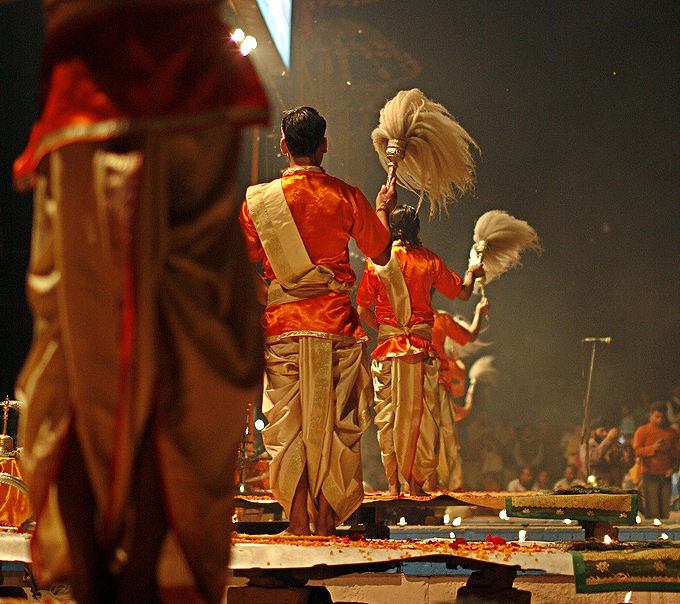
Abb.: आवृत् । Ganga-aarti - गङ्गा-आरती । Varanasi - वाराणसी,
Uttar Pradesh
[Bildquelle: Tony Kuneck. --
http://www.flickr.com/photos/83762626@N00/3566295444/. -- Zugriff am
2011-03-21. --
Creative
Commons Lizenz (Namensnennung, keine kommerzielle Nutzung, share alike)]
| 36c./d. paryāyaś cātipātas
tu syāt paryaya upātyayaḥ पर्यायश् चातिपातस् तु स्यात् पर्यय उपात्ययः ॥३६ ख॥ [Bezeichnungen für Übertretung:]
|
Colebrooke (1807): "Neglect. Of what is enjoined or customary."
| 37a./b. niyamo vratam astrī tac
copavāsādi puṇyakam नियमो व्रतम् अस्त्री तच् चोपवासादि पुण्यकम् ।३७ क। Etwas Verdienstvolles (पुण्यक - puṇyaka n.) wie Fasten (upavāsa m.) u. ä. heißt:
|
Colebrooke (1807): "Meritorious act. As fasting, &c."
Die beste, enzyklopädische Darstellung der vratas bei
Kane, Pandurang Vaman <1880 - 1972>: History of Dharmasastra : (ancient and mediaeval, religious and civil law). -- Poona : Bhandarkar Oriental Research Institute. -- Bd. V, 1. -- 2. ed. -- 1974. -- S. 1 - 462
"Apart from the secondary applications of the word vrata, its principal meaning from at least the first centuries of the Christian era onwards has been that of a religious undertaking or vow, observed on a certain tithi, week day, month or other period, for securing some desired object by the worship of a deity, usually accompanied by restrictions as to food and behaviour. This is the sense in which the word vrata will be used in this section. Vratas may be expiatory (i. e. they will be prāyaścittas) or obligatory (such as the vratas of a brahmacarin or snātaka or householder) or they may be voluntary and self-imposed for securing some specific end. Expiatory vratas have already been dealt with in the 4th volume of the H. of Dh. under Prāyaścittas. The vratas of a brahmacarin, of snātaka and of the householder have been treated of in volume II. of the H. of Dh. Vratas or vows that are more or less self-imposed will be discussed in this section of the 5th volume." (S. 27f.) "A vrata comprehends several items such as snāna ( bath ), the morning prayer (prataḥ-sandhyā), saṅkalpa, homa, pūjā of the deity or deities in whose honour or for securing whose favour the vrata is undertaken, upavāsa, feeding of brāhmaṇas, maidens or married women or the poor and helpless (according to the nature of the vrata), gifts (of cows, money, apparel, sweetmeats &c.) and the observance of certain rules of conduct during the period of the vrata." (S. 31)
"Classification of vratas : As the vratas to be treated of in this section are almost all self-imposed or voluntary, they may be divided into three classes. The Padmapurāṇa observes :
'ahiṃsā (abstaining from causing injury), truthfulness, not depriving a person of his property by wrongfully taking it, brahmacarya (continence ), freedom from crookedness or hypocrisy—these are mental vratas that lead to the satisfaction (or favour) of Hari;
eating once only in the day, nakta (eating only once after sunset), fast (for the whole day), not begging (i. e. subsisting on food that one gets without asking for it )-this is physical vrata for human beings;
study of the Veda, recounting (the name of) Viṣṇu, speaking the truth, freedom from backbiting, these are vratas of speech.'
Another classification can be based on the time for which a vrata may last, i. e. only for a day or a fortnight (pakṣa), a month, season, ayana { time of the stay of the Sun in the northern or southern hemisphere ), year, or years. A vrata may be for one year or for more years than one or for a person's lifetime. In speaking of vratas performed in a certain month, the question of an intercalary month will have to be considered and will be dealt with in the next section on Kāla etc. Similarly, the matter of tithis occupies a very large place in works on dharmaśāstra and will have to be discussed. The subject of Kāla and muhūrta will be dealt with in the next section. Though tithis properly pertain to that section, they will be dealt with here, since tithis are the most important topic in relation to the various observances that are to be performed throughout a year as their basis. The largest number of vratas are tithi-vratas. It is therefore that Hemādri begins his treatment of individual vratas with tithi-vratas ( from part I. p. 335 to part II. p. 519 ) and passes on in order to vāravratas (part II. pp. 520-592), nakṣatravratas part II. pp. 593-706 ), Yogavratas (part II. pp. 707-717), Karaṇavratas (part II. pp. 718-726 j, Saṅkrāntivratas (part II. pp. 727- "43), māsavratas (part II. pp. 800-857 ), ṛtuvratas ( part II. pp. ; 58-861 ), saṃvatsaravratas (part II. pp. 862-867), prakīrṇaka miscellaneous) vratas ( part II. pp. 867-1002). The Kṛtyakalpataru (on vrata) on the other hand begins with vāravratas pp. 8-34 ), then deals with tithivratas (pp. 35-398 ), nakṣatravratas (pp. 399-417 ), māsavratas ( pp. 418-430 ), saṅkrāntivratas pp. 431-434), saṃvatsaravratas (pp. 434-451 ) and prakīrṇavratas (pp. 452-459). Most of the works on vrata after dealing with some general matters begin their treatment of vratas with tithivratas. The Samayapradīpa has a different mode of treatment, viz. that it begins with Gaṇeśavratas (i. e. vratas in which Gaṇeśa is the deity, then with vratas in which the sun is the deity, then Śivavratas, Viṣṇuvratas and so on. Some vratas are performed not only on a certain tithi, but also require the existence of a certain month or weekday or nakṣatra or all of these. Another classification may be based on the persons competent to perform vratas; most vratas are meant for ill men and women; some like Haritālikā and Vaṭa-sāvitrī are meant for women alone, some are to be performed by men alone; while there are others to be performed only by kings or kṣatriyas or by vaiśyas.
There is an immense literature on vratas. There is no topic of Dharmaśāstra except probably that of tīrthayātra and of śrāddha on which the Purāṇas wax so eloquent as on vrata. Some of the Purāṇas contain thousands of verses on vrata. For example, the Brāhmaparva of the Bhaviṣyapurāṇa (in chapters 16-216) contains over 7500 verses and the Uttarakhṇḍda of the same Purāṇa over five thousand verses on vratas; the Matsyapurāṇa (chapters 54-92 and 95-101) has about 1230 verses on vrata ( most of which occur in the Padmapurāṇa V. chap. 20 ff.), the Varāhapurāṇa ( chap. 39-65 ) spends about 700 verses and the Viṣṇudharmottara about 1600 verses on vratas. On a modest calculation the Purāṇas contain about twenty-five thousand verses at least on vratas. It is difficult to draw a strict line between vratas and utsavas; what are called utsavas have also in element of religious rites and conversely many vratas have some element of being a festival." (S. 56f.)
[Quelle: Kane, Pandurang Vaman <1880 - 1972>: History of Dharmasastra : (ancient and mediaeval, religious and civil law). -- Poona : Bhandarkar Oriental Research Institute. -- Bd. V, 1. -- 2. ed. -- 1974.]
| 37c./d. upavastaṃ tūpavāsaḥ
vivekaḥ pṛthagātmatā उपवस्तं तूपवासः विवेकः पृथगात्मता ॥३७ ख॥ [Bezeichnungen für Fasten:]
|
Colebrooke (1807): "A fast."
उपवास - upavāsa m.: Fasten
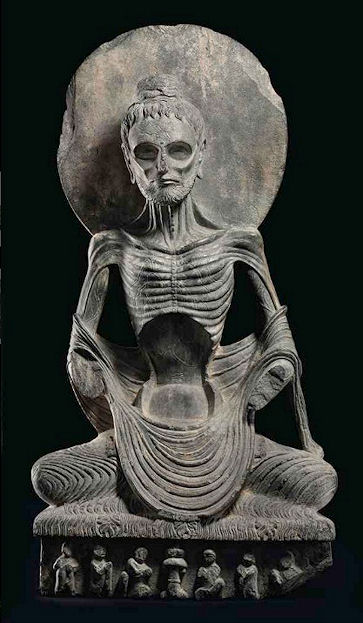
Abb.: उपवासः । Siddhārtha als Asket, Gandhara, 3./4. Jhdt. n.
Chr.
[Bildquelle: centralasian. --
http://www.flickr.com/photos/centralasian/5497689392/. -- Zugriff am
2011.-03-21. --
Creative
Commons Lizenz (Namensnennung)]
| 37c./d. upavastaṃ tūpavāsaḥ
vivekaḥ pṛthagātmatā उपवस्तं तूपवासः विवेकः पृथगात्मता ॥३७ ख॥
|
Colebrooke (1807): "Discrimination."
| 38a./b. syād brahmavarcasaṃ
vṛttādhyayanarddhir
athāñjaliḥ स्याद् ब्रह्मवर्चसं वृत्ताध्ययनर्द्धिर् अथाञ्जलिः ।३८ क। Erfolg in Verhalten und Studium heißt ब्रह्मवर्चस - brahmavarcasa n.: Leuchte im Veda, Auszeichnung in vedischem Wissen, geistlicher Vorrang, Heiligkeit |
Colebrooke (1807): "Holiness. Resulting from the study of scripture ; and the observance of its injunctions."
| 38. syād brahmavarcasaṃ vṛttādhyayanarddhir
athāñjaliḥ 38 pāṭhe brahmāñjaliḥ pāṭhe vipluṣo brahmabindavaḥ
स्याद् ब्रह्मवर्चसं वृत्ताध्ययनर्द्धिर्
अथाञ्जलिः । añjali1 bei der Vedarezitation heißt ब्रह्माञ्जलि - brahmañjali m.: Veda-añjali |
Colebrooke (1807): "Joining both hands while reading the Vedas. An act of humility, with a short prayer, at the beginning and end of a lesson : or else to mark, by the motion of the hands so joined, the accentuation, while reading the Sāma-veda."
1 añjali m. = Zwei miteinander verbundene Hohlhände (siehe: http://www.payer.de/amarakosa3/amara211c.htm)
| 38c./d. pāṭhe brahmāñjaliḥ
pāṭhe vipluṣo brahmabindavaḥ पाठे ब्रह्माञ्जलिः पाठे विप्लुषो ब्रह्मबिन्दवः ॥३८ ख॥ (Speichel)-Tropfen bei der Vedarezitation heißen ब्रह्मबिन्दु - brahmabindu m.: Veda-Tropfen |
Colebrooke (1807): "Sanctified saliva. Drops of spittle sputtered in reading the Vedas."
| 39a./b. dhyānayogāsane brahmāsanaṃ
kalpe vidhikramau ध्यानयोगासने ब्रह्मासनं कल्पे विधिक्रमौ ।३९ क। Der Yoga-Sitz bei der Meditation (dhyāna) heißt ब्रह्मासन - brahmāsana n.: Sitz des Brahman-Priesters, Veda-Sitz |
Colebrooke (1807): "A holy posture. Adapted to meditation and restraint of thought : sitting with the feed raised, or with fingers intertwined, &c."
| 39a./b. dhyānayogāsane brahmāsanaṃ
kalpe vidhikramau ध्यानयोगासने ब्रह्मासनं कल्पे विधिक्रमौ ।३९ क। Eine vedische Ritualvorschrift (kalpa m.) heißt:
|
Colebrooke (1807): "A sacred precept. Practice prescribed by the Vedas for the effecting of certain consequences."
विधि - vidhi m.: Vorschrift
"The Veda is also divided into ire parts viz. vidhi, arthavāda, mantra, nāmadheya and pratiṣedha. These five have already been mentioned above. Here some details will have to be added on each of these. Vidhi is an injunction (or exhortation) that is meaningful on account of enjoining a matter that has a (useful) purpose and it prescribes something that does not follow (or is not established) by any other authority. Śabara himself describes in many places what vidhi means. For example, the injunction 'one desirous of (attaining) Heaven should offer Agnihotra' prescribes (the performance of) homa that does not follow from any other authority and that has a beneficial purpose, its meaning being 'by the Agnihotra offering one should effect (the attainment of) svarga.' Where however, a rite is otherwise established, all that can be done only to enjoin an accessory with regard to it. Thus in a sentence 'one should offer an oblation with curds' the homa being already established by the words 'one should offer Agnihotra (if one desires heaven)' all that is enjoined is the offering of curds with regard to it, the meaning being 'by curds one should effect the oblation'. Vide Tup-ṭikā on P. M. VI, 3,17 and M. N. P. p. 17 ( B. O. E. I ed.). The collection of vidhis in the Vedic texts forms the core of the Veda and refers to many specific rites. The central element in a vidhi is the verb or verbal form, which will be analyzed later on. The question is: how is one to recognize a vidhi. Śabara quotes a verse which those who know the propositions about the meanings of words and sentences declare traditionally, viz. in all the Vedas the fixed (or definite) sign of a vidhi is the words 'one shall do', ' it should be done',' it ought to be done', ' it should be so', 'it ought to be so'. From this it follows that a vidhi is ordinarily couched in the optative form (called vidhi-liṅ Sanskrit), and that a verb in the present tense cannot ordinarily be taken as laying down a vidhi. But sometimes a vidhi may be inferred even from a text in which the verb is in the present tense."
[Quelle: Kane, Pandurang Vaman <1880 - 1972>: History of Dharmasastra : (ancient and mediaeval, religious and civil law). -- Poona : Bhandarkar Oriental Research Institute. -- Bd. V, 2. -- 1962. -- S. 1225f.]
क्रम - krama m.: Schritt, Reihenfolge, Ablauf des Ritus
"krama ("the order in which the several component parts or acts that go to make up a sacrifice are to come one after another). Vidhis speak of the performance of many acts in a sacrifice and do not always lay down the order in which those acts (principal and auxiliary) are to be performed." [Quelle: Kane, Pandurang Vaman <1880 - 1972>: History of Dharmasastra : (ancient and mediaeval, religious and civil law). -- Poona : Bhandarkar Oriental Research Institute. -- Bd. V, 2. -- 1962. -- S. 1313.]
| 39c./d. mukhyaḥ syāt prathamaḥ
kalpo 'nukalpas tu tato 'dhamaḥ मुख्यः स्यात् प्रथमः कल्पो ऽनुकल्पस् तु ततो ऽधमः ॥३९ ख॥ Die erste vedische Ritualvorschrift heißt मुख्य - mukhya m.: Hauptsächliche (Vorschrift) |
Colebrooke (1807): "A chief injunction. Regarding an act of religion : as 'sacrifice with rice;' 'strew Kuśagrass.'"
| 39c./d.
mukhyaḥ syāt prathamaḥ kalpo 'nukalpas
tu tato 'dhamaḥ मुख्यः स्यात् प्रथमः कल्पो ऽनुकल्पस् तु ततो ऽधमः ॥३९ ख॥ Eine der Hauptvorschrift untergeordnete Vorschrift heißt अनुकल्प - anukalpa m.: nachgeordnete vedische Ritualvorschrift |
Colebrooke (1807): "A secondary one. Or succedaneous : as ' for want of rice use Nibāri' : 'for want of Kuśa employ Caśa or Durvā."
| 40a./b. saṃskārapūrvaṃ grahaṇaṃ
syād upākaraṇaṃ śruteḥ संस्कारपूर्वं ग्रहणं स्याद् उपाकरणं श्रुतेः ।४० क। Das Inangriffnehmen des (Studiums des) Veda nach dem erforderlichen Saṃskāra [= Upanayana] heißt उपाकरण - upākaraṇa n.: Schuleröffnungsfeier. |
Colebrooke (1807): "Holy study. Reading the Vedas after initiation."
"Upākaraṇa, upākarman.— Schuleröffnungsfeier (WEBER, Nakṣatra II, 322, BÜHLER, IA. 23, 238 ff.). Śaṅkhāyana 4, 5, 15-16 wird in Śloken das Upākarma als das Werk der Ṛṣi's gepriesen, die es durch die Kraft ihres Tapas' erschauten. Die Schulen verzeichnen dafür folgende Zeit: Āśvalāyana, 3, 5, 2: wenn die Pflanzen erscheinen, der Mond in Śravaṇa steht, im Monat Śrāvaṇa. 3: oder am 5. Tage des Monats, im Nakṣatra Hasta. Man nennt dies Upākaraṇa das vārṣika (3, 5, 19). Pāraskara 2, 10, 2: wenn die Pflanzen erscheinen, der Mond in Śravaṇa steht, am Vollmondstage des Monats Śrāvaṇa oder am fünften Tage des Monats Śrāvaṇa unter dem Nakhsatra Hasta (cf. STENZLER'S Anm. über die Kommentarangaben). Śaṅkhāyana 4, 5, 2: wenn die Pflanzen erscheinen, unter Hasta oder Śravaṇa. Hiraṇyakeśin 2, 18, 2: in der zunehmenden Hälfte des Monats Śrāvaṇa, wenn die Pflanzen erschienen sind, unter dem Nakṣatra Hasta oder am Vollmondstage. Gobhila 3, 3, 1: am Vollmondstage des Monats Prauṣṭhapada oder unter dem Nakṣatra Hasta; doch erwähnt er 3, 3,13 auch »einige«, die am Vollmondstag des Śrāvaṇa beginnen (Khādira 3, 2, 16). Diese warten mit dem Studium bis zu dem Savitṛ-Tage. Vaikhānasa 2, 12 athāṣāḍhopākarma kuryāt; Kauśika 141, 2 an Śrāvaṇī oder prauṣṭhapadī. Am Semesteranfang findet ein Opfer statt. In Betreff der dabei zu beobachtenden Einzelheiten weichen die Lehrer innerhalb derselben Schule von einander ab. Śaṅkhāyana 4, 5, 3 ff. berichtet, dass man nach einigen die (aus ungemahlener Gerste und Getreide bestehende, mit saurer Milch und Schmelzbutter gemischte) Opferspeise mit dem Veda Vers für Vers opfert, oder mit den ersten Versen der Hymnen und Anuvāka's; nach Māṇḍūkeya mit den ersten Versen der Adhyāya's und der Ṛṣi's (d. i. der Liedergruppen, wie sie von den verschiedenen Ṛṣi's herstammen), dagegen nach Kauśitakin mit den ersten und letzten Versen der Maṇḍala's; die von Kauśitakin angegebene Weise schreibt auch Āśvalāyana 3, 5, 6 ff. vor, nur dass er sowohl den letzten Vers der Śākala- als der Bāṣkalaschule anführt. Dasselbe Gṛhyasūtra lässt zuerst zwei Ājyabhāga's opfern, dann Butterspenden an Sāvitrī, Brahman, Śraddhā, Medhā, Prajñā, Dhāraṇā, Sadasaspati, Anumati, an die Versmaße und Ṛṣi's, dann Gerste in saurer Milch im Anschluss an die oben genannten Verse. Nach Pāraskara 2, 10, 3 ff. wird, nach den beiden Ājyabhāga's und Butterspenden, beim Ṛgveda der Erde und Agni geopfert, beim Yajurveda dem Äther und Vāyu, beim Sāmaveda dem Himmel und der Sonne, beim Atharvaveda den Himmelsgegenden und dem Monde. Ferner bei jedem Veda Brahman und den Versmaßen, ferner Prajāpati, den Deva's, Ṛṣi's, Śraddhā, Medhā, Sadasaspati, Anumati. Mit dem Spruch Vājasaneyīsaṃhitā 32, 13: sadasaspatim opfert der Lehrer dreimal geröstete Körner und alle sprechen den Spruch nach.
Hiraṇyakeśin 2, 18, 3 lässt nach Anlegung des Feuers und Ablauf des Opfers bis zu den Vyāhṛti's den Ṛṣi's der Kāṇḍa's (»Soma, dem Ṛṣi des Kāṇḍa«, Agni usw.) opfern oder den Kāṇḍanamen, der Sāvitrī, Ṛgveda, Yajurveda, Sāmaveda, Atharvaveda, Sadasaspati (der Komm, zu Āpastamba. 8, 1. 2 unterscheidet den Anfang des Adhyāya, bei dem allen Ṛṣi's der Kāṇḍa's, und den des Kāṇḍa, bei dem dem Ṛṣi zu opfern ist). Nach Śaṅkhāyana 4, 5, 10 essen sie von der Opferspeise mit Ṛgveda. 4, 39, 6, lassen sich nieder, murmeln die mahāvyāhṛti's usw. und veranlassen den Lehrer zu Segenswünschen. Nach Pāraskara 2, 10, 13 ff. legen die Schüler jedesmal nach dem Körneropfer je ein Udumbara-holzscheit frisch, noch belaubt und mit Butter gesalbt unter Hersagung der Sāvitrī an; sofern sie jedoch noch Brahmacārins sind, in der sonst beim Samidādhāna des Schülers üblichen Weise (s. S. 53). Sie essen die gerösteten Körner, die saure Milch mit Yajussprüchen (cf. auch Gobhila 3, 3, 6. 7) und nachher sagt er zu den ihm Gegenübersitzenden: »Om!«, dreimal die Sāvitrī und die Anfänge der Kapitel, resp. der Ṛṣi's, Parvans, Sūkta's (s. S. 56), und alle flüstern einen auf ihre Gemeinsamkeit bezüglichen Segenswunsch (2, 10, 22). (Cf. noch Gobhila 3, 3, 2 ff.).
Nach diesem Upākaraṇa tritt eine Pause von drei Tagen ein (Śaṅkhāyana 4, 5, 17; Pāraskara 2, 10, 23; Hiraṇyakeśin 2, 18, 7: ein oder drei Tage) ehe das Studium beginnt.
Die Zahl der Schüler scheint nicht beschränkt gewesen zu sein. Śaṅkhāyana 4, 8, 2 ff. spricht von einem, oder zwei oder mehr Schülern, je nachdem Platz ist und Pāraskara 2, 10, 17 sagt, der Lehrer solle soviel Sesamkörner, als er sich Schüler wünsche, unter Hersagung der Sāvitrī oder des Anuvāka VS. 17, 80 ff. mit einem Würfelbrett opfern."
[Quelle: Hillebrandt, Alfred <1853-1927>: Ritual-Litteratur, vedische Opfer und Zauber. -- Strassburg, Trübner 1897. -- 199 S. -- (Grundriss der indo-arischen Philologie und Altertumskunde ; III,2). -- S. 58f.]
| 40c./d. same tu pādagrahaṇam
abhivādanam ity ubhe समे तु पादग्रहणम् अभिवादनम् इत्य् उभे ॥४० ख॥ [Bezeichnungen für respektvolle Begrüßung:]
|
Colebrooke (1807): "Obeisance. A bow or prostration to a person addressed by name."
पादग्रहण - pādagrahaṇa n.: Ergreifen der Füße
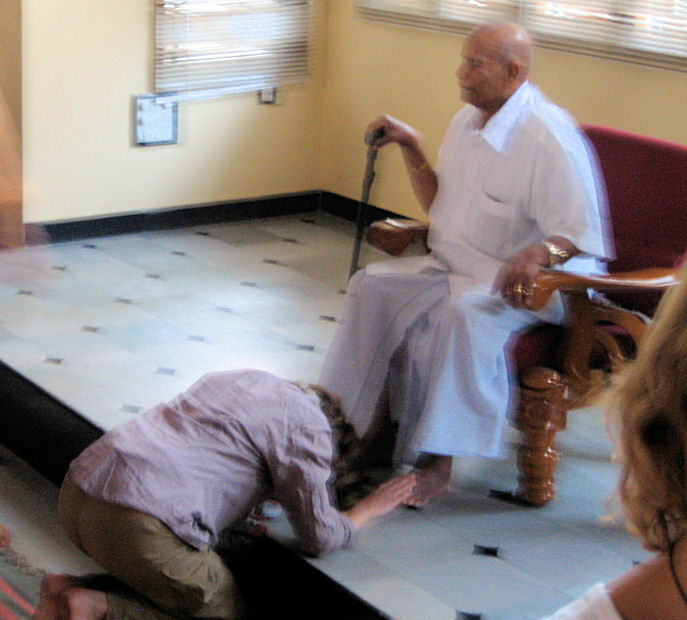
Abb.: पादग्रहणम्
। Mysore -
ಮೈಸೂರು,
Karnataka
[Bildquelle: Evan Lovely. --
http://www.flickr.com/photos/footfun/3114571015/. -- Zugriff am
2011-03-21. --
Creative
Commons Lizenz (Namensnennung)]
"Very detailed rules were laid down about pratyutthāna (rising from one's seat to receive a person ), abhivādana ( saluting a man), upasaṃgrahaṇa (saluting by clasping the feet of the teacher or another with one's hands), pratyabhivāda (returning a salutation ), and namaskāra (bowing with the word 'namaḥ'). According to Āp. Dh. S. I.2.5.19 and 1.3.10.17 the student must, when he meets his teacher after sunrise, clasp his teacher's feet and also before beginning the day's lesson of Vedic study and also after finishing it. Manu II. 71 says the same. Gaut. (I. 52-54) prescribes the clasping of the feet every day in the morning and at the beginning and at the end of a lesson in the Veda. According to Āp. Dh. S. I. 2.5.20 on other occasions whenever the student meets the teacher only abhivādana is sufficient, though according to some teachers (Āp. I. 2. 5. 21) clasping the teacher's feet is necessary on each occasion. Āp. Dh. S. I. 2. 5. 22 states that in upasaṃgrahaṇa the teacher's right foot is to be stroked below and above with the student's right hand and the foot and ankle are both to be taken hold of, while according to some teachers, the student must press each foot of the teacher with both hands and clasp them. Manu 11.72, Viṣṇu Dh. S.28. 15, and Baud. Dh. S. I. 2. 24 say that the student is to clasp the feet of the teacher with crossed hands, touching the right foot with the right hand and the left foot with the left hand. Kullūka on Manu II. 72 quotes Paiṭhīnasi that the student should clasp the teacher's feet with his hands turned upwards. Baud. Dh. S. I. 2. 28 adds that clasping should not be done when either the teacher or the pupil is seated, or is lying down or impure. According to Gaut. VI. 1-3 one must clasp every day on the first meeting and particularly on his or their return from a journey, the feet of one's parents, of the blood relations of parents (e. g. paternal and maternal uncles), of the elder brother, of the guru (i. e. ācaāya, upādhyāya) and of persons venerated by one's gurus. Āp. Dh. S. (I. 4. 14. 7-9 ) says that even after finishing one's studies and returning home a man must every day clasp the feet of gurus (father, mother, teacher and other venerable persons) and of elder brothers and sisters according to their seniority.
Abhivādana is of three kinds, viz. nitya (obligatory every day), naimittika (to be done only on certain occasions) and kāmya (to be done only if a person has certain rewards in view). As examples of nitya abhivādana one may instance the rules of Āp. Dh. S. (I. 2. 5. 12-13 ) "every day a student should get up from bed in the last watch of the night and standing near his teacher salute him with the words 'I so and so, ho' ( salute thee); and the student should also salute other very aged (and learned brāhmaṇas) who may reside in the same village before his morning meal." Yāj. I. 26 also speaks of the latter. The occasional abhivādana is done on certain occasions such as return from a journey ( Āp. Dh. S. I. 2. 5. 14 ). A person may salute elderly persons whenever he chooses, if he is desirous of long life or (bliss in) heaven ( Āp. Dh. S. I. 2. 5. 15 and Baud. Dh. S. 1.2. 26). Manu (II. 120 and 121) says ' the prāṇas ( vital breaths) of a young man mount upwards when an old man approaches; but by rising to meet him and salutation (to him ), he (the young man ) recovers them. He who habitually salutes and constantly pays reverence to the aged obtains an increase of four things viz. length of life, knowledge, fame and strength.' Āp. Dh. S. I. 4. 14. 11, Baud. Dh. S. I. 2. 44, Manu II. 130 and Vas. Dh. S. 13. 41 prescribe that a person must honour by rising and mentioning one's name an officiating priest, one's father-in-law, paternal and maternal uncles, even though these may be younger than oneself in years. Gaut. (VI. 9) however says that in the case of these one need only rise from his seat to receive them; but it is not necessary to salute them (abhivādana is not necessary). Viṣṇu Dh. S. 32. 4 expressly says that in the case of officiating priests and others specified by Āp. and Gaut. and who are younger, rising from one's seat is tantamount to abhivādana. Manu II. 117 says that one must perform abhivādana to a person from whom one learns secular, Vedic or spiritual knowledge of any kind. There is some difference in the words used at the time of abhivādana. Usually the words are ' abhivādaye devadatta-śarmā-ham bhoḥ' (vide Āp. I. 2. 5. 12, Gaut. VI. 5, Baud. Dh. S. I. 2. 27, Vas. XIII. 44, Manu II. 122 and 124). But this mode is appropriate only if the person addressed knows how to return the salutation. Manu II. 123 and 126 and Vas. Dh. S. 13. 45 declare that in the case of those who do not know how to return a salutation (pratyabhivādana, and according to Manu in the case of women also) one should omit the word 'bhoḥ' and simply say ' abhivādaye aham ' (omitting one's name ). Āp. Dh. S. I. 4. 14. 20 similarly says that in saluting women, a kṣatriya or a vaiśya one should use a pronoun and omit one's name.
The manner of abhivādana was as follows : A brāhmaṇa shall salute stretching forward his right arm on a level with his ear, a kṣatriya holding it on a level with the chest, a vaiśya holding it on a level with the waist and a śūdra holding it low (up to his feet) and that the salutation shall be by joining one's hands ' ( Āp. Dh. S. 1.2. 5.16-17). The Madanaparijāta adds that abhivādana is with both hands when the person to be saluted is learned, but with one hand only if he is not learned (p. 27) and the Sm. C. (I. p. 36) quotes Viṣṇu and Atri to the same effect. The stretching of the hands up to the ear &c. indicates how far the head is to be bent in each case.
There were also other rules about honouring one's elders in the presence of one's teacher or honouring the teacher's teacher or about one's behaviour when a gentleman comes to see one's ācārya and leaves him, which are here passed over for want of space. Vide Āp. Dh. S. I. 2. 6. 29-32, Manu II. 205.
A brāhmaṇa who does not know the form of returning a salutation must not be saluted by a learned man; he is like a śūdra ( Manu II. 126 ). Similarly a brāhmaṇa was not to perform abhivādana to a kṣatriya or a vaiśya however learned the latter may be, but one should simply say 'svasti'; those who are of the same caste should do abhivādana. The Mit. on Yāj. III. 292 and Aparārka p. 1188 quote sutras of Hārīta prescribing as prāyaścitta a fast of one, two or three days respectively for a brāhmaṇa saluting a kṣatriya, vaiśya or śūdra and also for saluting when the persons saluted or the man saluting are in such a condition as to make them unfit for abhivādana. One should not salute with the shoes on or when one's head is wrapped up or one's hands are full ( Āp. Dh. S. I. 4. 14. 19); or if one carries a load of fuel-sticks or holds a pot of flowers or food in one's hands one shall not salute, nor shall one salute on occasions similar to the preceding (such as one being engaged in worship of manes, of fire or other gods or when one's teacher is so engaged), nor should one salute a teacher standing very close to him (Baud. Dh. S. I. 2. 31-32). When one is impure or the person he meets is impure (owing to aśauca or other causes ) no salutation is to be made or returned ( Āp. Dh. S. I. 4. 14. 17). Gaut. IX. 45 says that one should not occupy a seat or perform abhivādana and namaskāra with shoes on". One need not salute a person who is not a guru or who stands in a lower or higher place than oneself (Āp. Dh. S. I, 4. 14. 14). Āp. Dh. S. I. 4. 14. 23, Manu II. 135 and Viṣṇu Dh. S. 32. 17 say that a brāhmaṇa ten years old is like a father to a kṣatriya even 100 years old and so deserves salutation from the kṣatriya.
Āp. Dh. S. (I. 4. 14. 12) gives a special rule that a friendship kept for ten years as fellow citizens, a friendship contracted at school for five years, the fact of a śrotriya being three years older entitles the friend or śrotriya to a salutation. But Gaut. ( VT. 14-17) and Manu II. 134 give somewhat different rules viz. contemporaries who are born in the same year are to be addressed with the word 'bhoḥ' or ' bhavat' and a fellow citizen who is ten years older than oneself and an artist who is five years older than oneself and a śrotriya studying the same Vedic school as oneself who is three years older are to be addressed similarly. Manu adds blood relations to the list when the difference in age is very small. The Smṛtyarthasāra p. 7 gives a long list of persons whom one should never salute viz. an heretic, a person guilty of grave sins, an atheist, gamblers, thieves, ungrateful persons, drunkards. Vide also Manu IV. 30 and Yāj. I. 130 ( as to showing no respect even by words to heretics &c )."
[Quelle: Kane, Pandurang Vaman <1880 - 1972>: History of Dharmasastra : (ancient and mediaeval, religious and civil law). -- Poona : Bhandarkar Oriental Research Institute. -- Bd. II, 1. -- 2. ed. -- 1974. -- S. 335 - 339.]
Zu brahmavarga Vers 41 - (Brahmanen: Askese II, )